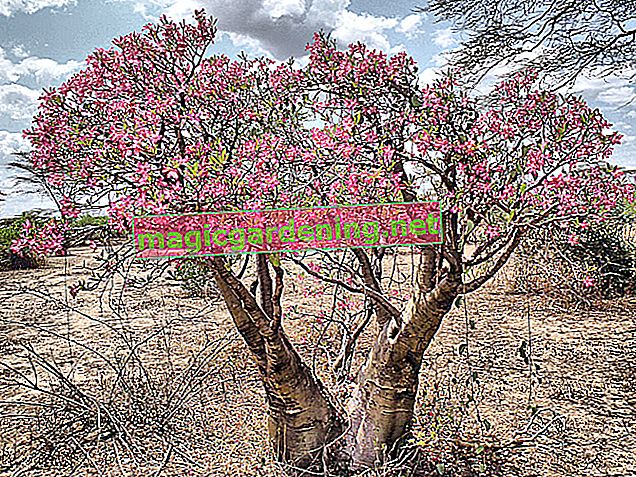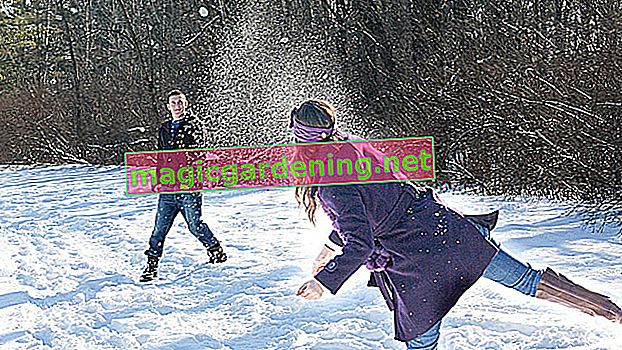
Cut spring-flowering shrubs after the flowering period
When spring-flowering shrubs unfold their buds, the cold season is over for good. The most beautiful species and varieties inspire with long-lasting flowering, decorative foliage coloring and / or attractive fruit decorations in autumn.
also read
- Pruning bushes in spring - tips and tricks
- How to cut your willow correctly - instructions in the tutorial
- Cut shrubs in autumn - tips and tricks
The flower buds for the color festival were already created in the previous year by spring bloomers, such as the wonderful forsythias, picturesque lilacs and spectacular bridal spar. In order not to destroy the valuable flower systems, cut these shrubs only after the flowering period . The pruning and the circumference of the pruning depend on whether the flowers develop on short-lived, one- to two-year-old or long-lived shoots. The following table names popular spring bloomers and distinguishes between short-lived and perennial blossom wood. You can read more in-depth explanations of the expert cut below the table.
| Flowers on short-lived shoots | Flowers on perennial wood |
|---|---|
| Spring spar, bridal spar (Spiraea thunbergii etc.) | Rock pear (Amelanchier lamarckii) |
| Broom gorse, dyer's gorse (Cytisus species) | Alpen-Waldrebe, Berg-Waldrebe (Clematis species) |
| Ornamental raspberry (Rubus species) | Dogwood flowers (Cornus florida, Cornus cousa) |
| Forsythia, golden bell (Forsythia) | Lilac (Syringa vulgaris) |
| Mayflower bush (Deutzia) | Pipebush, farmer's jasmine (Philadelphus coronarius) |
| Weigelia (Weigelia) | Barberry, buckthorn (Berberis) |
| Shrub Peony (Paeonia suffruticosa) | Ornamental cherries (Prunus species) |
| Honeysuckle (Lonicera) | Azalea (rhododendron species) |
Some popular spring flowers should not be pruned, or pruned very little. These include witch hazel (Hamamelis), magnolia (Magnolia), spindle bush (Euonymus alatus) or the cornel cherry (Cornus mas). That does not mean that using scissors and saws is completely taboo. Unfavorably standing branches or dead wood can be pruned without any problems.
Spring bloomers on short-lived shoots - this is how you cut correctly
For spring-flowering shrubs in this category, the following rule of thumb applies: the younger the shoots, the more luxuriant the flowers. As the illustration below shows, thorough thinning out contributes significantly to the promotion of young blossom wood. Thinning out ground shoots that have already flowered twice at the base. If you want an opulent spring bloom, no shoot should be more than 3 years old. How to cut properly:
- Cut back withered flowers to the next pair of leaves or a lower branch
- Thinning out ground shoots at the base that have already carried flowers two or three times
- Do not cut this year's young shoots (recognizable by the light, soft wood)
- Overhanging, strongly branched shoot tips lead to a lower, outwardly directed side shoot
The perfect pruning on bushes in this category aims at continuous rejuvenation . If you remove older ground shoots, there should already be a corresponding number of young shoots. Young wood can usually be recognized by its unbranched growth, light-colored bark and noticeably softer structure. At the time of cutting the shoots are still growing and will not be pruned.

Cut little spring blooms on old wood - this is how you do it right
When shrubs create their spring blossoms on perennial wood , the scissors are rarely used. Rock pear, alpine clematis, lilac and barberry bloom tirelessly, even if you don't have the scissors ready every year. How to cut bushes that let their spring blossoms shine on perennial shoots:
- After the flowering period: clean off withered flowers (snap off azaleas with your fingers)
- Do not clean bushes with autumn fruits
- Shoots that are hanging from the shrub or that are too long are slimmed down with a derivation cut
- Thin out dead wood, weak, frozen and inward-facing branches in February
Shrubs in this category also benefit from continuous rejuvenation - albeit in a slimmed-down form. In each late winter, look for the oldest or weakest ground shoot. Cut off the branch at the base to make room for a young scaffold shoot to replace it.

background
Divert long, heavily branched shoots instead of shortening them
The derivation cut is one of the fundamental basic techniques for cutting bushes. If you have mastered this cutting technique, you will never again struggle with unsightly gaps after a pruning. To cut a shoot that is too long or with a strongly branched tip, look for a side shoot positioned further down. This side shoot should be strong and vital and directed outwards. Use the scissors where old and young wood fork. The previously subordinate side drive now takes over the leadership position without the interface being recognizable as a gap. The figure below shows how to do it right.
Cut summer flowering shrubs in February
Summer-blooming shrubs shine in all their splendor on this year's shoots , which arise from a stable, permanent framework. This property allows a never-ending flowering period and makes pruning easy for the gardener. Top-class flowers in this category are buddleia (Buddleja davidii), garden hawkish (Hibiscus syriacus), summer sparrow (Spiraea japonica) and panicle hydrangea (Hydrangea paniculata) as well as snowball hydrangea (Hydrangea arborescens). How to cut your summer flowering ornamental trees correctly:
- The best time is in late winter (January to early March)
- First remove all dead, weak, crossed and inward-growing branches
- Cut back withered shoots from the previous year by half or a third
- For optimal bloom abundance, shorten all previous year's shoots to a few centimeters above the base on the main branch
In the first few years you build up a species-specific framework that consists of 3 to 7 (buddleia and hibiscus) or 10 to 15 (sparrows) ground shoots. In order to keep this structure young and vital, every year you thin out some of the oldest ground shoots and train young shoots to form new structures.

Special case of roses - cut bed and shrub roses twice a year
The queen of flowers insists on special treatment when it comes to pruning. As a result, many private rose gardeners are plagued by doubts and are too hesitant to cut the noble flowering bushes. The result is long-legged rose bushes that are bare at the bottom and have few flowers at the tips of the branches. Your bed and shrub roses can do this better if you pave the way for them with a courageous cut in spring. This is how it works:
- The best time for the main rose pruning is when the forsythia is in bloom (early March to early April)
- Cut off old and heavily lignified ground shoots at the roots
- Leave 3 or 4 of the most vital shoots on weakly growing rose bushes
- Thinning out strong-growing rose bushes up to 5 or 6 ground shoots worth preserving
- Cut back the remaining ground shoots to 20 cm or 4 eyes
Your rose bushes receive a rose care cut after the first flower pile . Depending on the type of rose, cut off withered flower heads above the next healthy leaf in June / July and again in September / October. Mainly remounting bed and shrub roses are dependent on repeated pruning. Once rose hips have formed, your rose bushes will rigorously refuse to bloom and can only be persuaded to have a weak second bloom in autumn.

Seldom cut evergreen deciduous shrubs
Evergreen deciduous trees have their leaves in every season of the year. High priests of creative garden design advocate choosing at least a fifth of all shrubs from evergreen species so that the winter garden is not left completely empty. If the basic green accord is not enough for you, you can turn to rhododendrons, whose magnificent flowers sparkle like gemstones above the evergreen foliage in spring. If yellow flowers glow in the shade in April and May, the evergreen Oregon grape accomplishes its floral masterpiece. Holly followed their inconspicuous spring blossom with bright red fruit decorations in winter.
Evergreen deciduous shrubs are popular with gardeners because they are easy to cut. This also applies to classic hedge bushes that stand out as an evergreen soloist, such as boxwood, laurel viburnum and cherry laurel. Make a note of these pruning measures in the care program for your evergreen deciduous shrubs:
- Rule of thumb: seldom cut evergreen shrubs, only when necessary
- The best time to clear dead wood and cut frozen branches: February to early March
- Best time for moderate pruning of individual shoots: end of June (St. John's Day) to mid / end of July
- Too long, protruding or balding shoots derive from a young side shoot
- Break out wilted rhododendron flowers by hand
When pruning long branches on evergreen shrubs, please leave 2 centimeters long cones . The cones make a valuable contribution to new growth. Especially sedate rhododendrons benefit from this cutting technique. But a cherry laurel as a solitary shrub also sprouts diligently when you prune on cones. The figure below uses the example of an evergreen laurel snowball to illustrate what is important when it comes to caring for the cut.

Tips
A separate tutorial is dedicated to hedge trimming. When flowering, deciduous or evergreen bushes gather to form a green wall, special pruning is required. You cut a formal hedge more often than a free-growing natural hedge. You can read here what you should pay attention to when cutting hedges as a privacy screen, bed border and enclosure.
Complete rejuvenation cuts in winter - this is how you turn back time
If deciduous shrubs are not cut or thinned for many years, they age. The formerly magnificent flowering and ornamental trees degenerate into an unsightly undergrowth of many old and a few young shoots. Often there is no way for scissors and saws to clear out individual branches. Instead of clearing out old shrubs, turn the floral wheel of time with a rejuvenating cut and try to rebuild. The chances of success depend on the basic cut tolerance of the plant species. The following overview summarizes the general framework conditions for professional cutting:
- The best time is during the deciduous period between November and February
- In the first step, remove as large a proportion of deadwood as possible
- Cut back shrubs that are compatible with pruning to knee height or level with the ground
- Rejuvenate sensitive shrubs in stages: rejuvenate a quarter of the shoots each winter
Various types of wood are not suitable for a rejuvenation cut. Magnolias, farm hydrangeas, dogwoods, witch hazel and other shrubs that naturally do not tolerate pruning are important here. Before you radically prune shrubs or put them on the cane, please ask at your trusted nursery.
background
Winter rejuvenation cuts respect the summer grace period
For many decades, the pitiful bird beeping from bushes and hedges was lost in the summer din of hedge trimmers. The weeks before and after St. John's Day at the end of June were traditionally considered to be the time for pruning. The increasing sensitization for the native animal world in general and threatened breeding birds in particular caused a rigorous rethinking. This is expressed in the Federal Nature Conservation Act. Paragraph 39 bans hedges and tree pruning between March 1st and September 30th. Light maintenance cuts are permitted if it is guaranteed that there are no nesting birds in the wood. Radical pruning measures such as thinning out and putting on the stick may be carried out from October 1st to February 28th, provided that there is a hedge,Do not stop the tree or bush from feathered or fur-bearing winter guests.How to Properly Prune Coniferous Shrubs
Conifers thrive as evergreen shrubs with a dense coniferous dress. In contrast to evergreen deciduous shrubs, needled shrubs are not good at pruning. The reason for the unruly growth behavior is the lack of sleeping eyes. Below their green needles, conifers do not have dormant buds from which they could sprout after a vigorous pruning. Thuja, cypress or juniper bushes naturally develop a harmonious shape and can confidently do without pruning. If cheeky shoots disturb the well-groomed appearance or if dead wood spreads inside the bush, you can remedy the problem as follows:
- Rule of thumb for pruning conifers: always cut in the green shoot area
- The best time is between January and the beginning of March on a frost-free day
- Too long shoots in the needled area lead to short side shoots inside the bush
- Only thin out dead wood if there is no bald spot or brown gap
Coniferous shrubs that are too large cannot be radically reduced in size by pruning. In this case, you should replace the conifers with a younger species that is naturally small. A rejuvenation cut on conifers inevitably results in the total failure of the shrubs.
Exception: yew impresses with its good-natured cut tolerance
The notable exception in terms of pruning tolerance are yew trees (Taxus). All species are adaptable and tolerate a cut into the old wood, provided that the measure is unavoidable. The densely-needled conifer is popular among home gardeners for the evergreen bed border or year-round privacy hedge. Without a regular topiary, the yew tree develops into a multi-stemmed shrub that reaches a majestic 10 to 15 meters high when old. In the small garden, slender columnar yew trees are useful as decorative solitary shrubs or elegant hedges. However, the yew tree is highly poisonous and not suitable for the family garden.
Irrespective of a good-natured pruning tolerance, an annual maintenance pruning on yew trees is not necessary. If individual, extra-long shoots protrude from the bushes, a derivation cut solves the aesthetic problem. Yew bushes that have grown too big can be rejuvenated and shrunk in stages over several years. The best time to cut is in February. Cut a quarter of the longest branches back to short cones. Strong branches lead you to a young, short side shoot.
Digression
The right tool turns shrubs into a successful project
Some of the most beautiful shrubs hide their hard, stubborn wood with furious flowers, like the wonderful lilac. But evergreen shrubs such as boxwood and deciduous hornbeam are also classified as hardwoods. For the perfect cut, high-quality scissors and saws in branded quality are just as important as the cut itself. This also applies to softwood shrubs whose shoots are squeezed by inferior blades and which provide an open flank for pathogens. We recommend a basic set of: one-hand scissors (up to 1.5 cm thick), one-hand pruning shears with ratchet gears (up to 3 cm thick), two-hand pruning shears (up to 4 cm thick) and a folding saw (€ 17.70 at Amazon * ) or hacksaw for the really thick branches.frequently asked Questions
I want to create a natural garden. Which shrubs are best suited as a bird source?
Domestic wild trees are a paradise for birds and insects. The bushes adorn the garden with their magnificent abundance of flowers, dense foliage and bright berries. We recommend hawthorn (Crataegus prunifolia), wild pear (Pyrus communis), black elder (Sambucus nigra), cornel cherry (Cornus mas), sloe (Prunus spinosa) and rock pear (Amelanchier lamarckii). We would like to recommend wild roses such as the sand rose (Rosa carolina) and the dog rose (Rosa canina). The bushes bloom tirelessly from summer to the first frost and provide native bird species with nutritious rose hips a valuable source of food.
The harsh winter this year left many of my shrubs in the garden with frost damage. What can I do?
Wait until the beginning / middle of May. After the ice saints you can see the extent of the frost damage. Cut the affected bushes back into the healthy wood. You can easily determine the transition from frozen to vital wood. Scrape off some of the bark with your fingernail or knife. Frozen wood can be identified as brown, dark tissue. You can recognize healthy wood by its fresh green color and juicy consistency.
I would like to place the beautiful flower balls of hydrangeas in my garden. Which hydrangea bushes remain decorative and vital even without annual pruning?
Farmers' hydrangeas beautify the garden with nostalgic flowers without you having to cut the bushes. On the contrary, Hydrangea macrophylla and the varieties derived from it are extremely sensitive to cutting. They already plant the flower buds for the coming year in the previous year, so pruning in late winter is not advisable. Pruning is limited to cleaning out withered flower heads to make room for the buds underneath. Continuous rejuvenation is recommended. From the fourth year on, the oldest ground shoots should be removed in exchange for young ones.
Are ground cover shrubs to be cut in the same way as upright shrubs?
The most popular shrubs with creeping shoots are ivy (Hedera hexlix), fat man (Pachysandra terminalis) and the indestructible loquat (Cotoneaster dammeri). It is up to your individual assessment whether and to what extent you cut the ground cover. In any case, it is advantageous for strong branching and dense foliage if you shorten too long tendrils by a third or half in late winter. This ensures that your ground cover shrubs will green the soil opaque and reliably suppress annoying weeds.
The 3 most common mistakes
When shrubs keep their flowers under lock and key, conifers are blighted with brown gaps or ornamental trees grow old prematurely in their prime, they are the victims of a cutting error. So that you do not make a mishap in pruning garden shrubs, the following table lists the 3 most common pruning errors with damage and gives tips for prevention.
| Cutting errors | Damage | prevention |
|---|---|---|
| wrong cutting time | Failure of the flowers | Cut spring flowers after the flowering period, summer flowers in February |
| Conifers cut into the old wood | brown gaps that no longer close | Always cut coniferous bushes in the needled area of the shoot |
| never exposed | Shrubs that are balding from inside and below, prematurely aging | Regularly remove deadwood from all bushes |
Tips
When you transplant shrubs in the garden, a large part of the root volume is lost. Most species and varieties can cope with the loss better if you cut back all shoots by at least a third to a maximum of two thirds. Shrubs that are sensitive to cut should not be bothered with scissors in this case either. These include farm hydrangeas (Hydrangea macrophylla), rhododendrons and azaleas (rhododendron species).








